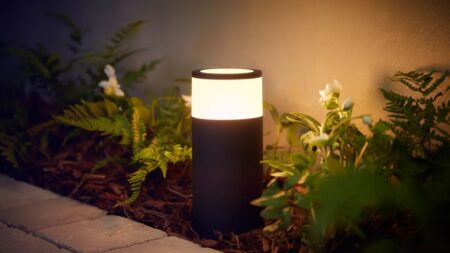No home is complete without good lighting. It can significantly impact your home’s overall look, safety, and energy efficiency. The average American household spends an estimated $200 yearly on lighting consumption, which accounts for at least 20% of their total energy bill. It means that aside from affecting the overall aesthetics of your home, improving the quality of light in your home might also help you save money in the long run. There are numerous tips and tricks to improve your home lighting.
If you want to improve the lighting in your home but don’t know where to start, this article will give you ten easy steps to get started and improve illumination. These tips will not help you better illuminate your home, but save you some money and add an aesthetic touch while at it. See which ones fit you the best. Happy homemaking!
Maximize Natural Light
The first step towards improving the lighting in your home is to maximize natural light. If you live in a sunny area, you can take advantage of as much sunlight as possible throughout the day.
There are many benefits to having more natural light in your home. The most obvious one being, freshness and welcoming ambiance it brings to home interiors. You can simply use curtains or shades such as zebra shade to block direct sunlight when necessary.
Another one is the savings you can achieve with a reduced utility bill. More natural light reduces need for artificial lighting, resulting in lower electricity consumption.

There are numerous ways to maximize natural light inside your home. You can positions mirrors in key areas as they draw light to dark corners; employ solar shades to help get filtered light in, add skylights and install big windows and doors that will increase access to natural light.
Use LED Lights
LED lights are more energy-efficient compared to traditional, incandescent bulbs, so they’re great for saving energy. They last longer, so you won’t need to replace them as often.
Using LED lights can save you over $225 on annual energy costs. You can find LED bulbs in all shapes and sizes, including recessed fixtures, table lamps, chandeliers, and outdoor spotlights. LEDs can simply be broken down into four major categories of shapes: A-shape, reflector, decorative, and specialty.
If your home still uses incandescent bulbs, it is time to switch to LED lights. You can gradually go through this change or buy a bunch of new ones and mix and match different colors and styles until you find something you like.

Pro tip: Colored lighting can enhance certain psychological effects, or simply exhibit a theme or event. Therefore, you should install colored LEDs with warm shades such as orange and yellow to set happy and lively ambiances, and cool colors like green and blue to offer a quiet and balanced atmosphere.
Also Read: LEDs Provide Ambient Lighting and Create a Variety of Moods at Home
Install Track Lights
Track lights is another way to add extra light to your room without relying solely on overhead lighting. It’s a type of lighting where fixtures are attached anywhere on a continuous track device containing electrical conductors. You can control and adjust the amount of light coming into each part of the room as these fixtures are flexible and can be positioned accordingly.
This lighting method is advantageous for rooms with high ceilings because it allows you to create a nice ambient glow without putting up any additional overhead lights. However, it is best suited to illuminate dark hallways. You can also use it to highlight artwork or photos.

It allows you to place lights anywhere in your room, giving you flexibility in how best to irradiate specific areas. It doesn’t have any specific function but it gives you endless possibilities to improve lighting in your home.
Add More Fixtures
Another simple way to improve a room’s lighting is to add more fixtures. Adding a few wall sconces or pendant lights can brighten up a dark corner or hallway, while a handful of floor lamps can do wonders for a living room or dining room.
There are three main types of lighting fixtures that you can incorporate into your living space to ameliorate illumination:
Ambient: These fixtures provide soft light and are typically used in hallways, stairwells, and less trafficked parts of the house.
Task: Task lighting is designed to highlight specific activities within a space, such as reading, working, cooking, etc. These are used in the kitchen, bedroom, study, and living room.
Accent: Accent lighting adds visual interest to a space, usually in the form of decorative fixtures. They can be used to highlight a gallery wall or artwork.

Depending on your choice and requirement, you can employ any of the abovementioned fixtures to enhance the lighting in your home. Fortunately, there is a wide variety of shapes, sizes, and shades that will reflect your personality and give your décor an upgrade as well.
Consider Using Recessed Lighting
Recessed lighting is perfect for kitchens, bathrooms, and laundry rooms as it doesn’t require drilling or cutting into walls. This lighting method uses lighting fixtures installed into the ceiling or wall. They sit level with the surface for a smooth look, and the fixture appears to light from within the opening. It also provides a softer look than standard surface-mounted fixtures.
If you want to ensure your recessed lighting looks good, consider installing dimmers to get complete control over the brightness level of the light, which makes it easy to turn off the light completely when not needed.

It can also be used in water-sensitive spaces without having to worry about damage. You can also employ recessed lighting to highlight specific items in your home, such as artwork and pictures of loved ones.
Incorporate Layered Lighting
Layered lighting is a type of architectural lighting that uses layers of diffusers to soften the light coming from the fixture. The result is a beautiful, warm glow that creates a cozy atmosphere. Layered lighting can enhance the ambiance in a living room, study, or bedroom. It’s especially useful if you want to create a relaxing environment while still being able to see what you’re doing.
Layered lighting employs multiple lighting types to create a well-illuminated and balanced area. This method focuses on different aspects for different purposes or to create a particular mood. For instance, it mixes and matches numerous light sources in a room to serve you as you work in the daytime and transform the mood for entertaining evening or cozy nighttime reading.

This method puts ambient, task, accent, and decorative lighting to use. To improve lighting in your home through layered lighting, you can invest in a control device for switching and dimming; use numerous lamps for different tasks, and incorporate lighting fixtures in accordance with natural light.
Control Lights With Automation System
Another option for improving your home lighting is an automated lighting system. An automated system lets you set the time at night when you want the lights to come on and go off. You can choose between turning the lights on manually or automatically based on the time of the day.
According to the U.S. Energy Information Administration (EIA), automated lighting systems are so popular today that 10 million American households use them to their advantage. Automation is an excellent option for people who don’t want to be bothered with turning lights on and off or manually controlling the ambiance of their spaces by mixing light temperatures.
This aspect of smart lighting helps you remotely control the lighting, and minimize unnecessary consumption. Apart from being able to turn lights on and off remotely, you can change the intensity of light by adjusting the brightness of a particular fixture. If you are using colored LED bulbs, you will even be able to change the color of your smart lighting.

Moreover, an automated system can even be used as a security measure. For instance, when someone tries to break into your home, the lights switch on and scare the intruders away. You can have motion sensors around your property perimeter, triggering which will keep intruders at bay and your home safe.
Not only that, motion sensors are very convenient and can turn lights on as soon as you enter the house. This comes in handy when your hands are full and you can’t switch on the lights until you place the stuff in your hands down.
Install Dimmer Switches
By installing a dimmer switch you are able to control and adjust the overall brightness of one or more fixtures. This type of lighting control works by changing the amount of electricity running through the circuit.
These dimmer switches can alter the mood of a room, lower the light brightness when watching a movie, set the mood for a romantic dinner, or dim the bathroom lights in the morning. This helps you save money on energy bills as well. You can save up to 25 percent in energy costs when you dim lights by 25 percent.

The dimmer switch gives you complete control over the amount of light you want in a particular space. You can lessen the light yield and help the bulb last longer. You can save on your utility costs and curtail the costs of bulb replacements.
Use Smart Switches
While lighting fixtures say a lot about the aesthetic of a home, smart light switches exhibit the beauty of the latest technology. Smart light switches are WiFi-enabled switches that allow you to control and customize your home lighting.
These internet-connected light switches help minimize your manual turning on and off of lighting. You should choose creative smart light switches whether you are looking to improve interior space, incorporate smart features, or enjoy contactless benefits.
Also Read: Modern Light Switch Designs to Beautify Your Home Interiors

When you press a smart light switch, it sends a wireless signal to control your lights. It can turn lights on and off, adjust brightness, or cycle through ambiance with your preferred color and brightness configurations.
Replace Old Bulbs
Don’t forget to replace the old bulbs. Old bulbs tend to get pretty hot, so they should be replaced before they burn out. If you’re unsure when to replace your bulbs, the rule of thumb is that when the light appears dimmer than usual, it’s most probably time to replace it.
An average incandescent bulb lasts up to 1,000 hours, while a fluorescent lamp can reach 15,000 to 20,000 hours of life span. As mentioned above, LED lights have the longest lifespan, reaching up to 50,000 hours.
Lighting is one of those things that most homeowners overlook until something goes wrong. But by thinking about how you want your home to look, you can ensure that everything works well together. Use these eight easy tips to improve and achieve the perfect lighting scheme for your home.
Follow Homecrux on Google News!




